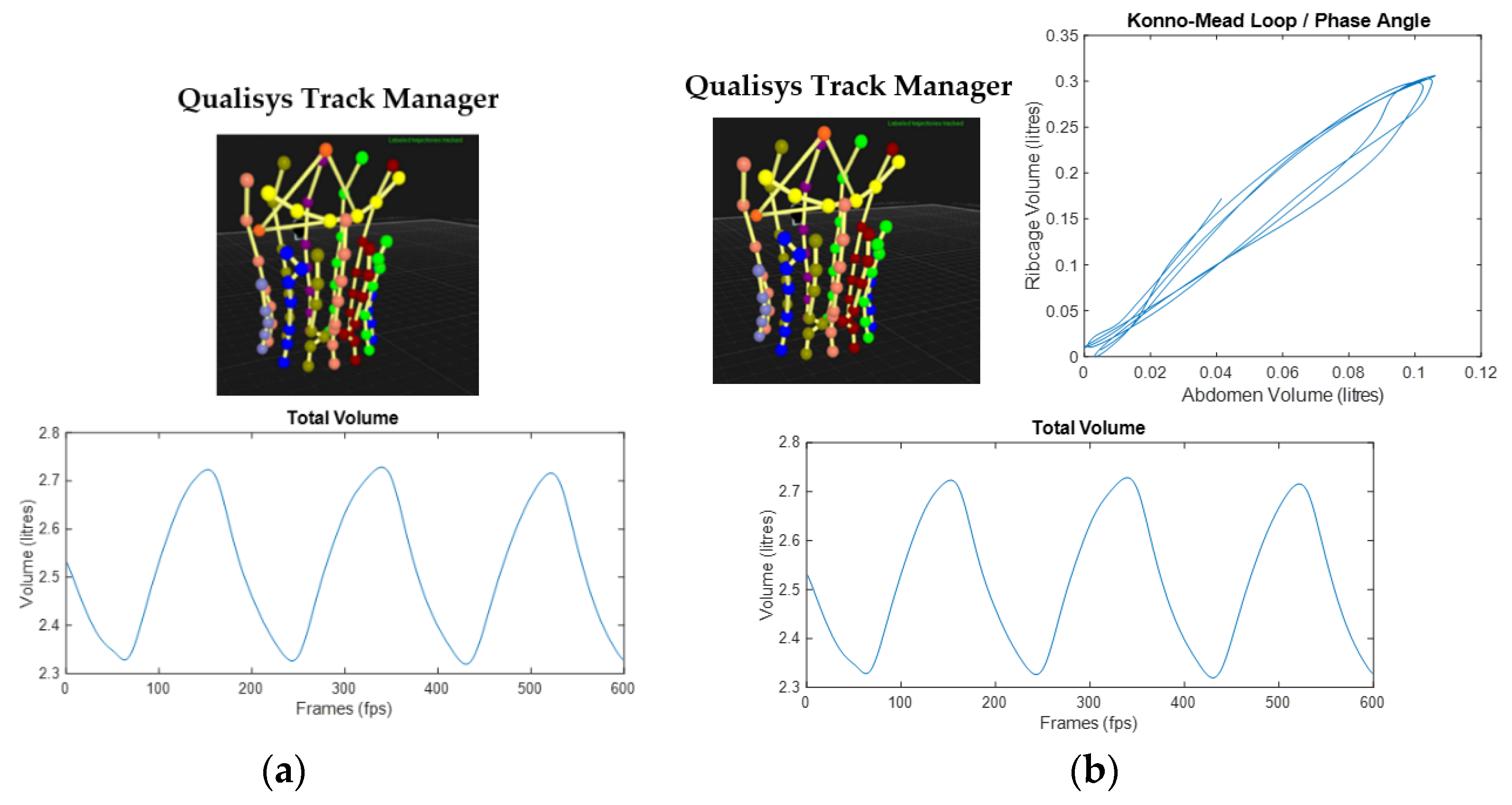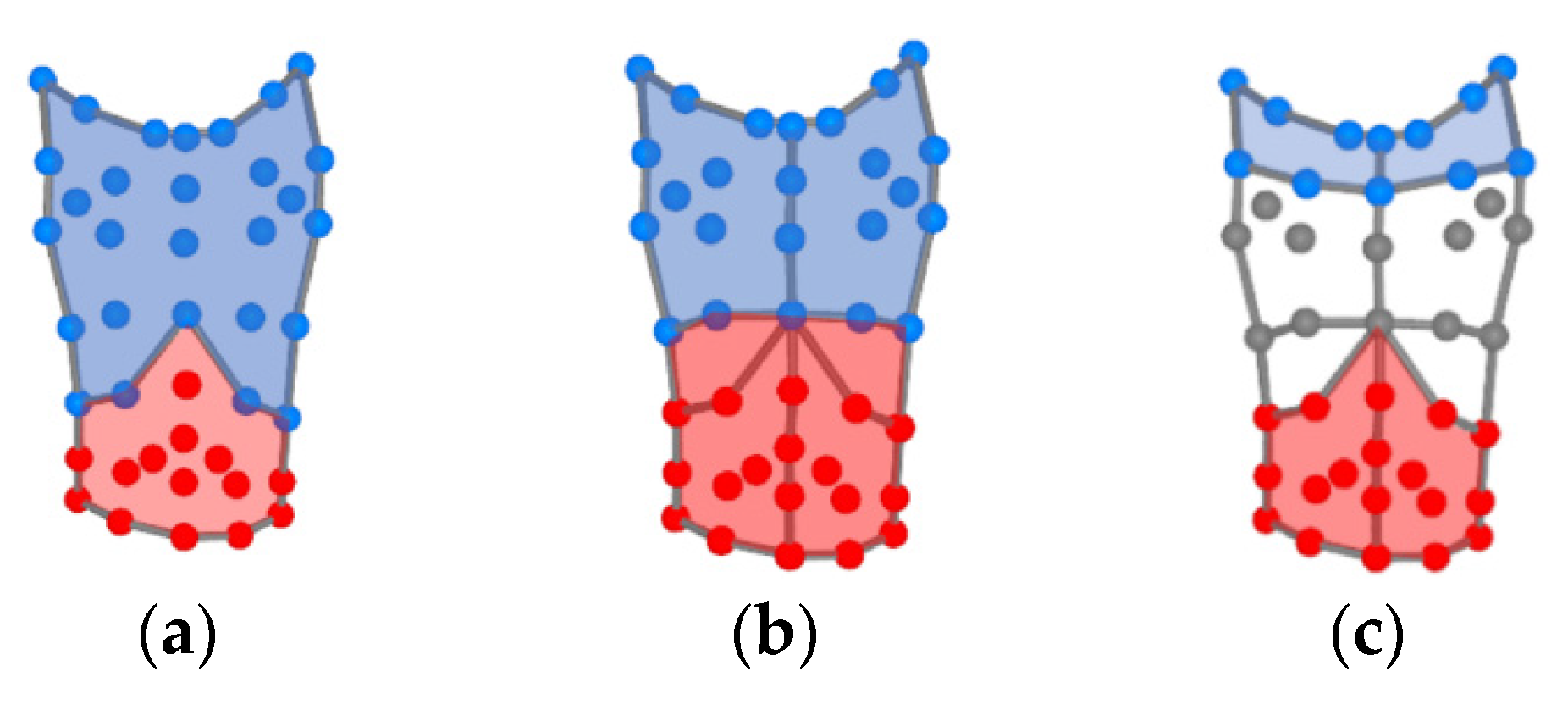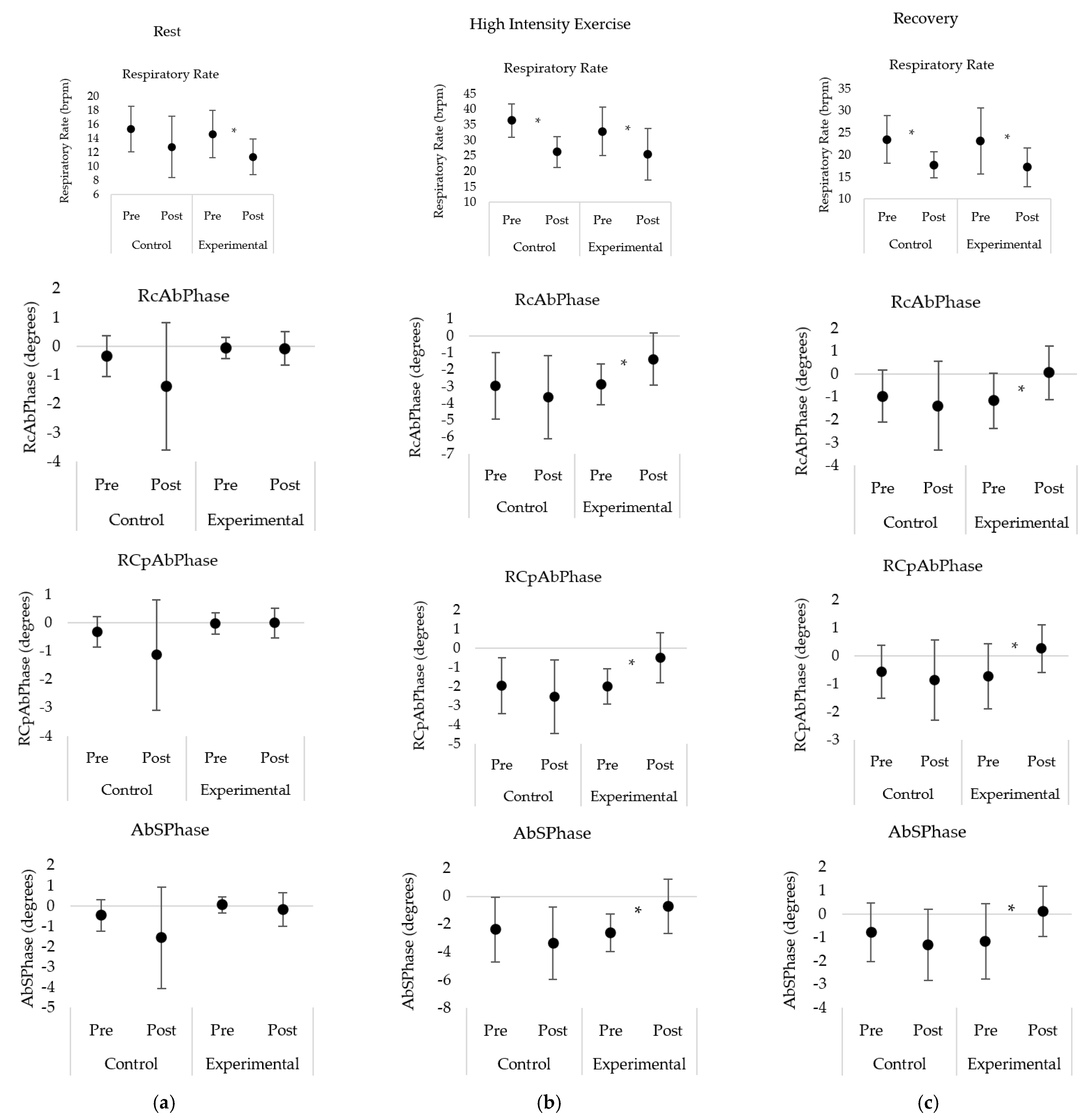Novel Real-Time OEP Phase Angle Feedback System for Dysfunctional Breathing Pattern Training—An Acute Intervention Study
Abstract
1. Introduction
2. Materials and Methods
2.1. Participants
2.2. Equipment
2.3. Protocol
2.4. Breathing Retraining Intervention
2.5. Data Analysis
3. Results
4. Discussion
5. Conclusions
Author Contributions
Funding
Institutional Review Board Statement
Informed Consent Statement
Data Availability Statement
Conflicts of Interest
References
- Boulding, R.; Stacey, R.; Niven, R.; Fowler, S.J. Dysfunctional breathing: A review of the literature and proposal for classification. Eur. Respir. J. 2016, 25, 287–294. [Google Scholar] [CrossRef] [PubMed]
- Barker, N.; Everard, M. Getting to grips with dysfunctional breathing. Paediatr. Respir. Rev. 2015, 16, 53–61. [Google Scholar] [CrossRef] [PubMed]
- Hagman, C.; Janson, C.; Emtner, M. Breathing retraining—A five year follow up of patients with dysfunctional breathing. Respir. Med. 2011, 105, 1153–1159. [Google Scholar] [CrossRef]
- Thomas, M.; McKinley, R.K.; Freeman, E.; Foy, C. Prevalence of dysfunctional breathing in patients treated for asthma in primary care: Cross sectional survey. Br. Med. J. 2001, 322, 1098–1100. [Google Scholar] [CrossRef] [PubMed]
- Courtney, R.; Biland, G.; Ryan, A.; Grace, S.; Gordge, R. Improvements in multi-dimensional measures of dysfunctional breathing in asthma patients after combined manual therapy and breathing retraining protocol: A case series report. J. Osteopath. Med. 2019, 31, 36–43. [Google Scholar] [CrossRef]
- Veidal, S.; Jeppegaard, M.; Sverrild, A.; Backer, V.; Porsbjerg, C. The impact of dysfunctional breathing on the assessment of asthma control. Respir. Med. 2017, 123, 42–47. [Google Scholar] [CrossRef] [PubMed]
- Bott, J.; Blumenthal, S.; Buxton, M.; Ellum, S.; Falconer, C.; Garrod, R.; Harvey, A.; Hughes, T.; Lincoln, M.; Mikelsons, C.; et al. Guidelines for the physiotherapy management of the adult, medical, spontaneously breathing patient. Thorax 2009, 64, 1–52. [Google Scholar] [CrossRef] [PubMed]
- Jones, M.; Harvey, A.; Marston, L.; O’Connell, N.E. Breathing exercises for dysfunctional breathing/hyperventilation syndrome in adults. Cochrane Database Syst. Rev. 2013, 5. [Google Scholar] [CrossRef]
- Thomas, M.; Bruton, A. Breathing exercises for asthma. Breathe 2014, 10, 313–322. [Google Scholar] [CrossRef]
- Bradley, H.; Esformes, J. Breathing pattern disorders and functional movement. Int. J. Sports Phys. Ther. 2014, 9, 28–39. [Google Scholar] [PubMed]
- Bowler, S.D.; Green, A.; Mitchell, C.A. Buteyko breathing techniques in asthma: A blinded randomized controlled trial. Altern. Med. 1998, 169, 575–578. [Google Scholar] [CrossRef]
- Holloway, E.A.; West, R.J. Integrated breathing and relaxation training (the Papworth method) for adults with asthma in primary care: A randomized controlled trial. Asthma 2007, 62, 1039–1042. [Google Scholar] [CrossRef]
- Singh, V.; Wisniewski, A.; Britton, J.; Tattersfield, A. Effect of yoga breathing exercises (pranayama) on airway reactivity in subjects with asthma. Lancet 1990, 335, 1381–1383. [Google Scholar] [CrossRef]
- Barker, N.J.; Jones, M.; O’Connell, N.E.; Everard, M.L. Breathing exercises for dysfunctional breathing/hyperventilation syndrome in children. Cochrane Database Syst. Rev. 2013, 12. [Google Scholar] [CrossRef]
- Paisani, D.M.; Lunardi, A.C.; da Silva, C.C.B.M.; Porras, D.C.; Tanaka, C.; Carvalho, C.R.F. Volume rather than flow incentive spirometry is effective in improving chest wall expansion and abdominal displacement using optoelectronic plethysmography. Respir. Care 2013, 58, 1360–1366. [Google Scholar] [CrossRef]
- Tomich, G.M.; Franca, D.C.; Diniz, M.T.C.; Britto, R.R.; Sampaio, R.F.; Parreira, V.F. Effects of breathing exercises on breathing pattern and thoracoabdominal motion after gastroplasty. J. Bras. Pneumol. 2010, 36, 197–204. [Google Scholar] [CrossRef] [PubMed][Green Version]
- Bruton, A.; Lee, A.; Yardley, L.; Raftery, J.; Arden-Close, E.; Kirby, S.; Zhu, S.; Thiruvothiyur, M.; Webley, F.; Taylor, L.; et al. Physiotherapy breathing retraining for asthma: A randomized controlled trial. Lancet Respir. Med. 2018, 6, 19–28. [Google Scholar] [CrossRef]
- Aliverti, A.; Dellaca, R.; Pelosi, P.; Chiumello, D.; Pedotti, A.; Gattinoni, L. Optoelectronic plethysmography in intensive care patients. Am. J. Respir. Care Med. 2000, 161, 1546–1552. [Google Scholar] [CrossRef] [PubMed]
- Hmeidi, H.; Motamedi-Fakhr, S.; Chadwick, E.; Gilchrist, F.J.; Lenney, W.; Iles, R.; Wilson, R.C.; Alexander, J. Tidal breathing parameters measured using structured light plethysmography in healthy children and those with asthma before and after bronchodilator. Physiol. Rep. 2017, 5, e13168. [Google Scholar] [CrossRef] [PubMed]
- Carry, P.Y.; Baconnier, P.; Eberhand, A.; Cotte, P.; Benchetrit, G. Evaluation of respiratory inductive plethysmography, accuracy for analysis of respiratory waveforms. Chest 1997, 111, 910–915. [Google Scholar] [CrossRef] [PubMed]
- Smyth, C.M.E.; Winter, S.L.; Dickinson, J.W. Optoelectronic plethysmography derived breathing parameters can differ between athletes with and without a dysfunctional breathing pattern during exercise. In Proceedings of the IEEE International Workshop on Metrology for Industry 4.0 & IoT, Rome, Italy, 3–5 June 2020; pp. 54–58. [Google Scholar]
- Massaroni, C.; Venanzi, C.; Silvatti, A.P.; Presti, D.L.; Saccomandi, P.; Formica, D.; Giurazza, F.; Caponero, M.A.; Schena, E. Smart textile for respiratory monitoring and thoraco-abdominal motion pattern evaluation. J. Biophotonics 2018, 11, e201700263. [Google Scholar] [CrossRef]
- Islam, S.M.; Yavari, E.; Rahman, A.; Lubecke, V.M.; Boric-Lubecke, O. Multiple subject respiratory pattern recognition and estimation of direction of arrival using phase-comparison monopulse radar. In Proceedings of the IEEE Radio and Wireless Symposium, Orlando, FL, USA, 20–23 January 2019; pp. 1–4. [Google Scholar]
- Layton, A.M.; Moran, S.L.; Garber, C.E.; Armstrong, H.F.; Basner, R.C.; Thomashow, B.M.; Bartels, M.N. Optoelectronic plethysmography compared to spirometry during maximal exercise. Respir. Physiol. Neurobiol. 2013, 185, 362–368. [Google Scholar] [CrossRef] [PubMed]
- De Melo Barcelar, J.; Aliverti, A.; Rattes, C.; Ximenes, M.E.; Campos, S.L.; Brandao, D.C.; Fregonezi, G.; de Andrade, A.D. The expansion of the pulmonary ribcage during breath stacking is influenced by age in obese women. PLoS ONE 2014, 9, 110959. [Google Scholar]
- Sarmento, A.; de Andrade, A.F.; Lima, I.N.; Aliverti, A.; de FreitasFregonezi, G.A.; Resqueti, V.R. Air stacking: A detailed look into physiological acute effects on cough peak flow and chest wall volumes of healthy subjects. Respir. Care 2017, 62, 432–443. [Google Scholar] [CrossRef]
- Brandao, D.C.; Lage, S.M.; Britto, R.R.; Parreira, V.F.; de Oliveira, W.A.; Martins, S.M.; Aliverti, A.; de Andrade Carvalho, L.; do Nascimento, J.F.; Alcoforado, L.; et al. Chest wall regional volume in heart failure patients during inspiratory loaded breathing. Respir. Physiol. Neurobiol. 2012, 180, 269–274. [Google Scholar] [CrossRef] [PubMed][Green Version]
- Albuquerque, A.L.; Quaranta, M.; Chakrabarti, B.; Aliverti, A.; Calverley, P.M. Exercise performance and differences in physiological response to pulmonary rehabilitation in severe chronic obstructive pulmonary disease with hyperventilation. J. Bras. Pneumol. 2016, 42, 121–129. [Google Scholar] [CrossRef]
- Vieira, D.S.R.; Mendes, L.P.S.; Elmiro, N.S.; Velloso, M.; Britto, R.R.; Parreira, V.F. Breathing exercises: Influences on breathing patterns and thoracoabdominal motion in healthy subjects. Braz. J. Phys. Ther. 2014, 18, 544–552. [Google Scholar] [CrossRef]
- Konno, K.; Mead, J. Measurement of the separate volume change of rib cage and abdomen during breathing. J. Appl. Physiol. 1967, 22, 407–422. [Google Scholar] [CrossRef]
- Parsons, J.P.; Hallstrand, T.S.; Mastronarde, J.G.; Kaminsky, D.A.; Rundell, K.W.; Hull, J.H.; Storms, W.W.; Weiler, J.M.; Cheek, F.M.; Wilson, K.C.; et al. An official American thoracic society clinical practice guideline: Exercise-induced bronchoconstriction. Am. J. Respir. Crit. Care Med. 2013, 187, 1016–1027. [Google Scholar] [CrossRef]
- Anderson, S.D.; Brannan, J.D. Methods for indirect challenge tests including exercise, eucapnic voluntary hyperpnea, and hypertonic aerosols. Clin. Rev. Allergy Immunol. 2003, 24, 27–54. [Google Scholar] [CrossRef]
- Massaroni, C.; Cassetta, E.; Silvestri, S. A novel method to compute breathing volumes via motion capture system: Design and experimental trials. J. Appl. Biomech. 2017, 33, 361–365. [Google Scholar] [CrossRef] [PubMed]
- Muyor, J.M. Exercise intensity and validity of the rating of perceived exertion (Borg and OMNI scales) in an indoor cycling session. J. Hum. Kinet. 2013, 39, 93–101. [Google Scholar] [CrossRef] [PubMed]
- Courtney, R. The functions of breathing and its dysfunctions and their relationship to breathing therapy. Int. J. Osteopath. Med. 2009, 12, 78–85. [Google Scholar] [CrossRef]
- Gosselink, R. Breathing techniques in patients with chronic obstructive pulmonary disease (COPD). Chron. Respir. Dis. 2004, 1, 163–172. [Google Scholar] [CrossRef]




| Breathing Parameter | Control Group | Experimental Group | Interaction | |||||||
|---|---|---|---|---|---|---|---|---|---|---|
| Pre | Post | Pre | Post | Effect p-Value | ||||||
| Mean | SD | Mean | SD | Mean | SD | Mean | SD | |||
| Rest | RR (brpm) | 15.32 | 3.22 | 12.80 | 4.38 | 14.63 | 3.37 | 11.39 | 2.55 † | 0.728 |
| RcAbPhase (deg) | –0.34 | 0.70 | –1.39 | 2.21 | −0.05 | 0.37 | −0.08 | 0.58 | 0.113 | |
| RCpAbPhase (deg) | −0.33 | 0.54 | −1.14 | 1.94 | −0.02 | 0.37 | −0.01 | 0.52 | 0.142 | |
| AbSPhase (deg) | −0.47 | 0.78 | −1.57 | 2.49 | 0.04 | 0.40 | −0.18 | 0.81 | 0.067 | |
| High Intensity Exercise | RR (brpm) | 36.41 | 5.42 | 26.27 | 4.97 † | 32.90 | 7.79 | 25.51 | 8.27 † | 0.398 |
| RcAbPhase (deg) | −2.97 | 1.98 | −3.65 | 2.48 | −2.89 | 1.20 | −1.39 | 1.54 † | <0.01 * | |
| RCpAbPhase (deg) | −1.96 | 1.46 | −2.54 | 1.93 | −2.00 | 0.93 | −0.50 | 1.31 † | <0.01 * | |
| AbSPhase (deg) | −2.39 | 2.34 | −3.38 | 2.61 | −2.60 | 1.35 | −0.72 | 1.97 † | <0.01 * | |
| Recovery | RR (brpm) | 23.52 | 5.35 | 17.76 | 2.97 † | 23.19 | 7.51 | 17.19 | 4.36 † | 0.946 |
| RcAbPhase (deg) | −0.96 | 1.15 | −1.38 | 1.95 | −1.16 | 1.21 | 0.06 | 1.16 † | <0.05 * | |
| RCpAbPhase (deg) | −0.56 | 0.94 | −0.86 | 1.42 | −0.73 | 1.15 | 0.26 | 0.86 † | <0.05 * | |
| AbSPhase (deg) | −0.78 | 1.26 | −1.31 | 1.52 | −1.17 | 1.61 | 0.11 | 1.08 † | <0.01 * | |
Publisher’s Note: MDPI stays neutral with regard to jurisdictional claims in published maps and institutional affiliations. |
© 2021 by the authors. Licensee MDPI, Basel, Switzerland. This article is an open access article distributed under the terms and conditions of the Creative Commons Attribution (CC BY) license (https://creativecommons.org/licenses/by/4.0/).
Share and Cite
Smyth, C.M.E.; Winter, S.L.; Dickinson, J.W. Novel Real-Time OEP Phase Angle Feedback System for Dysfunctional Breathing Pattern Training—An Acute Intervention Study. Sensors 2021, 21, 3714. https://doi.org/10.3390/s21113714
Smyth CME, Winter SL, Dickinson JW. Novel Real-Time OEP Phase Angle Feedback System for Dysfunctional Breathing Pattern Training—An Acute Intervention Study. Sensors. 2021; 21(11):3714. https://doi.org/10.3390/s21113714
Chicago/Turabian StyleSmyth, Carol M. E., Samantha L. Winter, and John W. Dickinson. 2021. "Novel Real-Time OEP Phase Angle Feedback System for Dysfunctional Breathing Pattern Training—An Acute Intervention Study" Sensors 21, no. 11: 3714. https://doi.org/10.3390/s21113714
APA StyleSmyth, C. M. E., Winter, S. L., & Dickinson, J. W. (2021). Novel Real-Time OEP Phase Angle Feedback System for Dysfunctional Breathing Pattern Training—An Acute Intervention Study. Sensors, 21(11), 3714. https://doi.org/10.3390/s21113714







